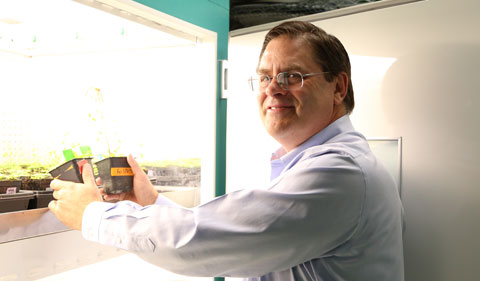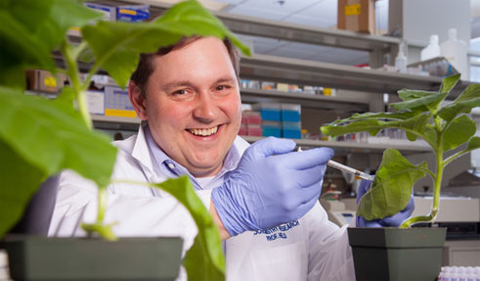
From left: Michael Held (Chemistry), Li Tan (Chemistry Alum 2003), Allan Showalter, (Plant Biology), Yadi Zhou (Chemistry graduate student) in Asilomar, CA, in June.
Ohio University researchers from Environmental & Plant Biology and Chemistry & Biochemistry presented at the VIII. Cell Wall Research Conference in Asilomar, CA, June 18-22.
The presenters included Dr. Allan M. Showalter, Dr. Michael Held, and graduate student Yadi Zhou.

Dr. Allan Showalter’s lab is studying Arabidopsis thaliana, a plant commonly used as a model organism for genetic studies.
Showalter, Professor and Chair of Environmental & Plant Biology and a faculty member in the Molecular and Cellular Biology program, presented a short talk and poster titled “Characterization of higher order hydroxyproline-O-galactosyltransferase mutants and glucuronosyltransferase mutants that function in arabinogalactan-protein glycosylation, growth, and development in Arabidopsis.”
Co-authors include Dasmeet Kaur, Oyeyemi Ajayi, Stacy Welker, Ashton Smith, Weiheng Yu, Olivia Perkins, Haylee Vajdich, and Yuan Zhang.
Abstract: Arabinogalactan-proteins (AGPs) are cell wall glycoproteins found throughout the plant kingdom and are extensively post translationally modified by conversion of proline to hydroxyproline (Hyp) and by addition of arabinogalactan polysaccharides (AGs) to Hyp residues. Here, we summarize our recent research progress on the Hyp-O-galactosyltransferases (GALTs) responsible for the initiation of AGP glycosylation and on the glucuronosyltransferases (GLCATs), which add glucuronic acid (GlcA) to AGs. We have produced several new, higher order mutants from the eight member GALT gene family contained within the GT31 family, which includes GALT2-6 and HPGT1-3. These new mutants include: three triple mutants, galt5hpgt2hpgt3, galt2hpgt2hpgt3, and galt5hpgt1hpgt2; two quadruple mutants, galt2galt5hpgt1hpgt3 and galt2gal5hpgt1hpgt2 and one quintuple mutant, galt2galt5hpgt1hpgt2hpgt3. These higher order mutants display considerably more abnormal phenotypes compared to previously characterized single galt and hpgt mutants and indicate gene redundancy. The abnormal phenotypes include lower germination rates, decreased plant height, smaller rosette leaves, delayed flowering, smaller siliques, decreased root length, and longer lateral roots under conditional salt stress in the preliminary studies.
We are also focusing our attention on three GLCAT family members contained within the GT14 family, namely GLCAT14A, GLCAT14B, and GLCAT14C, all of which are known to transfer GlcA to AGs. Previously, only the glcat14a mutant was phenotypically characterized. We have more completely characterized this glcat14a mutant and extend mutant characterization to glcat14b and glcat14c, as their mutants were not previously isolated. Additionally, we have produced two double mutants (glcat14aglcat14c and glcat14bglcat14c) and are in the process of producing the remaining double mutant and triple mutant. These mutants showed significant reductions in the inner layer of seed mucilage, enhanced cell elongation in etiolated hypocotyls and roots. Additionally, glcat14c, but not glcat14a and glcat14b, demonstrated root swelling in 4.5% sucrose.
Finally, we are using CRISPR/Cas9 technology to expedite the production of higher order mutants for both of these glucosyltransferase families. Progress using this approach will be discussed and compared to the more common T-DNA based/plant breeding approach which we have used.
In conclusion, this work has begun to dissect the importance of specific glycosyltransferase genes to AGP functions and elucidated their redundant nature.
Held, Associate Professor of Chemistry & Biochemistry and a faculty member in the Molecular and Cellular Biology program, presented a poster titled “Characterization of an extensin-crosslinking cell wall peroxidase.”
Co-authors are John Elmore, Alexis Benedis, and Sarah Hill.
Abstract: Previous work in our lab has identified an anionic tomato cell wall peroxidase (TomEP) that shows specific intermolecular extensin crosslinking activity. While several tomato extensins have been identified as substrates of the TomEP in vitro, the direct physiological targets of TomEP have yet to be explored. Previous research has also indicated a potential role for TomEP and extensin crosslinking in response to mechanical wounding and pathogen stress. This work therefore aims to help define TomEP’s biochemical roles in vivo through both expression analyses and gain- and loss-of-function experiments directly in tomato (Solanum lycopersicum). Mutant lines are being generated using poly-cistronic tRNA-gRNA (PTG) CRISPR technology, while overexpression lines have been generated by traditional agrobacterium-mediated transformation. Expression of TomEP is being investigated using both promoter-GUS fusions and qPCR analysis—both approaches measuring basal expression and wound response over time. By characterizing TomEP activity and expression, its roles in normal plant cell growth and division, as well as in response to pathogen stress and wounding can be better understood, possibly opening new lines of research toward improving pathogen-resistance in crop plants.
Zhou, a graduate student in Chemistry & Biochemistry, presented a poster titled “Construction of a Barley Global Gene Co-expression Network using RNA-Seq data.”
Abstract: With the accumulation of large-scale RNA sequencing data of plants in recent years, RNA-Seq-based gene co-expression networks (GCNs) have been constructed for several agricultural crops, such as rice, maize, wheat, and soybean, to unravel gene functions and their regulatory mechanisms. Barley (Hordeum vulgare) is a cereal crop rich in dietary fiber and is important in food, livestock feeding, and brewing industries. Several barley GCNs have been published. Some were done using microarray-based data, while others were local GCNs from RNA-Seq data under certain conditions or treatments. In our study, barley global GCNs were constructed using gene-level expression data from 339 publicly available barley RNA-Seq libraries that cover a wide range of tissues and developmental stages. To build a robust global GCN for barley, RNA-Seq libraries were selected with care, and several expression data normalization and network inference methods were tested. Networks were evaluated using a pathway dataset and a protein-protein interaction dataset. An optimal network with the best performance was selected for further analysis. Topological properties of the optimal barley GCN were examined. The barley GCN was further divided into modules to reveal the functionalities of each module. We are currently investigating the module that is enriched in cell wall biosynthesis related functions to discover unknown cell wall genes and to understand their regulatory mechanisms.





















Comments